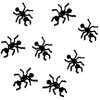- Formiculture.com
- Forums
- Gallery
- Members
- Member Map
- Chat

Working with hydrostone
Started By
Kalidas
, Aug 25 2020 5:57 PM
4 replies to this topic
#1
 Offline
-
Posted August 25 2020 - 5:57 PM
Offline
-
Posted August 25 2020 - 5:57 PM
Okay Ant people's need some help/advice when it comes to working with hydrostone.
So some of you MAY remember my desire to make a specialized formicarium design for an Acromyrmex Versicolor colony. My idea is actually VERY similar to Drew's, a nest box on top of a water reservoir that will all evaporated water to flow upwards and humidify the nest box.
What I have done is bought two decently sized hobby display cases that will stand one top of one another. The bottom will have water, an aquarium heater, and an air stone to help facilitate the flow of liquid up into the nest.
Originally I had an idea to put Firestone brick's up top and carve out a cave like structure in them for the ants to nest in. This was not great for getting high levels of humidity.
Instead I will be doing something else, the idea will be to create a bottom layer of hydrostone and the front and back of the box I will create "arches" made of hydrostone to mimic a cave like structure.
This serves two functions, one is simply for asthetics, the second is to cover the holes I will still into the box which in where the water vapors will flow from.
So here's the question. What's a good way to make the arches? Should I just place a kind of physical object against the nest box with a backing to hold everything in place, pour, dry and then remove the physical object leaving the dried hydrostone shape? That's my current idea, not sure there something better though.
So some of you MAY remember my desire to make a specialized formicarium design for an Acromyrmex Versicolor colony. My idea is actually VERY similar to Drew's, a nest box on top of a water reservoir that will all evaporated water to flow upwards and humidify the nest box.
What I have done is bought two decently sized hobby display cases that will stand one top of one another. The bottom will have water, an aquarium heater, and an air stone to help facilitate the flow of liquid up into the nest.
Originally I had an idea to put Firestone brick's up top and carve out a cave like structure in them for the ants to nest in. This was not great for getting high levels of humidity.
Instead I will be doing something else, the idea will be to create a bottom layer of hydrostone and the front and back of the box I will create "arches" made of hydrostone to mimic a cave like structure.
This serves two functions, one is simply for asthetics, the second is to cover the holes I will still into the box which in where the water vapors will flow from.
So here's the question. What's a good way to make the arches? Should I just place a kind of physical object against the nest box with a backing to hold everything in place, pour, dry and then remove the physical object leaving the dried hydrostone shape? That's my current idea, not sure there something better though.
- Scherme likes this
#2
 Offline
-
Posted August 25 2020 - 9:27 PM
Offline
-
Posted August 25 2020 - 9:27 PM
I personally did not like the water reservoir under the nest style because I wasn't sure how much of volume of water was going up from capillary action and actually penetrating the hydrostone. I would rather place a tube (clear or not) from the top, attached to the hydrostone, and with a rubber stopper closing the tube. This way, you don't have to open the lid every time to moisten the hydrstone, reducing humidity loss. I am working on a leaf cutter formicarium atm as well. Just got a drill press to makes necessary holes, organic dyes for the hydrostone, and waiting for the hydrostone to arrive. I'll post some pics soon.
Edited by zantezaint, August 25 2020 - 9:29 PM.
https://www.formicul...ale-california/
4 x Solenopsis xyloni (Fire ant) colonies.
2 x Veromessor andrei (Seed-harvester ant) colonies.
19 x Pogonomyrmex subnitidus (Seed-harvester ant) colonies + 3 x Pogonomyrmex (ID uncertain) colonies
16 x Linepithema humile (Argentine ant) colonies.
1 x Unknown Formicidae colony.
1 x Tapinoma sessile (Odorous house ant) colony.
1 x Camponotus fragilis (Carpenter/wood ant) colony + 1 x Camponotus sansabeanus (Carpenter/wood ant) colony.
1 x Solenopsis molesta (Thief ant) colony.
#3
 Offline
-
Posted August 26 2020 - 4:38 AM
Offline
-
Posted August 26 2020 - 4:38 AM
Following.
It would seem easiest to me to make a form to fill within the nest box as you said.
I just started working with hydrostone, I have been making the petri founding chambers.
I want to experiment a lot with it.
Please post pics, if you can, of what you do come up with.
Tetramorium immigrans | Journal
Lasius Neoniger | Journal
Camponotus Pennsylvanicus | Journal
Camponotus Chromaiodes | Journal
Schermicarium - DIY | Journal
#4
 Offline
-
Posted August 26 2020 - 11:55 AM
Offline
-
Posted August 26 2020 - 11:55 AM
I personally did not like the water reservoir under the nest style because I wasn't sure how much of volume of water was going up from capillary action and actually penetrating the hydrostone. I would rather place a tube (clear or not) from the top, attached to the hydrostone, and with a rubber stopper closing the tube. This way, you don't have to open the lid every time to moisten the hydrstone, reducing humidity loss. I am working on a leaf cutter formicarium atm as well. Just got a drill press to makes necessary holes, organic dyes for the hydrostone, and waiting for the hydrostone to arrive. I'll post some pics soon.
That seems to be pretty common with leaf cutters(another common one is to put the leaf cutter box on a platform open topped in an aquarium with warmed water as a moat that will also warm and humidify the nest box.)
I still need to order the hydrostone lol
#5
 Offline
-
Posted August 26 2020 - 4:37 PM
Offline
-
Posted August 26 2020 - 4:37 PM
I personally did not like the water reservoir under the nest style because I wasn't sure how much of volume of water was going up from capillary action and actually penetrating the hydrostone. I would rather place a tube (clear or not) from the top, attached to the hydrostone, and with a rubber stopper closing the tube. This way, you don't have to open the lid every time to moisten the hydrstone, reducing humidity loss. I am working on a leaf cutter formicarium atm as well. Just got a drill press to makes necessary holes, organic dyes for the hydrostone, and waiting for the hydrostone to arrive. I'll post some pics soon.
That seems to be pretty common with leaf cutters(another common one is to put the leaf cutter box on a platform open topped in an aquarium with warmed water as a moat that will also warm and humidify the nest box.)
I still need to order the hydrostone lol
I've done the moat style with Acromyrmex versicolor queens, and they ended up drowning.
https://www.formicul...ale-california/
4 x Solenopsis xyloni (Fire ant) colonies.
2 x Veromessor andrei (Seed-harvester ant) colonies.
19 x Pogonomyrmex subnitidus (Seed-harvester ant) colonies + 3 x Pogonomyrmex (ID uncertain) colonies
16 x Linepithema humile (Argentine ant) colonies.
1 x Unknown Formicidae colony.
1 x Tapinoma sessile (Odorous house ant) colony.
1 x Camponotus fragilis (Carpenter/wood ant) colony + 1 x Camponotus sansabeanus (Carpenter/wood ant) colony.
1 x Solenopsis molesta (Thief ant) colony.
1 user(s) are reading this topic
0 members, 1 guests, 0 anonymous users















